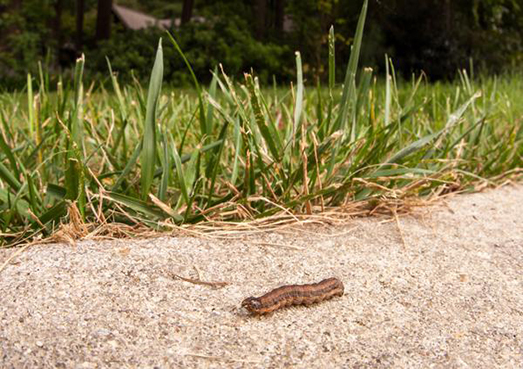Your Cart

Are you noticing brown patches of grass in your lawn? Do the edges of the grass blades appear to be chewed in these patches? If so, you may be dealing with an armyworm infestation. Because these insects are extremely destructive, identification and quick treatment are absolutely crucial. Contrary to what the name suggests, full-grown armyworms are not actually worms – they are moths. Before reaching full maturity, however, armyworms do resemble worms in their larval stage, and these worm-like pests can cause serious damage to the lawn. Armyworms get their name from the way that they “march” across turf grass in an army-like fashion. When larvae consume available food sources, they migrate as an army to new host plants. These bugs are native to North America and can be found east of the Rocky Mountains, reaching into southern Canada. Armyworm larvae vary in color from dark greenish-brown to black. They have long white, orange, and dark brown stripes along the length of the abdomen. Armyworm moths migrate from the southern U.S. states in April and May. They are active during the evening, feeding on nectar, mating, and searching for areas – like your lawn! – to lay their eggs. Armyworm eggs are deposited in rows or clusters on the lower leaves of grasses or at the base of plants; these typically hatch in one to two weeks, beginning the larval stage. During the daytime, armyworm larvae can be found under plant debris, or in the top few inches of the soil. Armyworm larvae are active at night, feeding on turf grass plants. This is the cause of the damage that homeowners tend to see on their lawns, which results in brown patches in the lawn. After completing six instars, larvae pupate just below the soil surface. Adults emerge in one to two weeks. A second generation will occur in late June or early July, followed by a third in late August or early September. Promptly treating potentially devastating armyworm infestations can help protect the investment you have made in a lawn care program and your property. If you notice suspicious brown patches starting to appear in the lawn, contact your Weed Man Professional as soon as possible to minimize damage. Weed Man can verify the presence of an infestation, discuss preventative measures, and recommend treatment if required. Request a free quote today!What are armyworms?
What do armyworms look like?

Mature larvae are approximately 1.5 inches long. The head capsule is a yellowish-brown with a brown network of veins, which gives the armyworm a mottled appearance.Armyworm lifecycle
What can be done about armyworms?